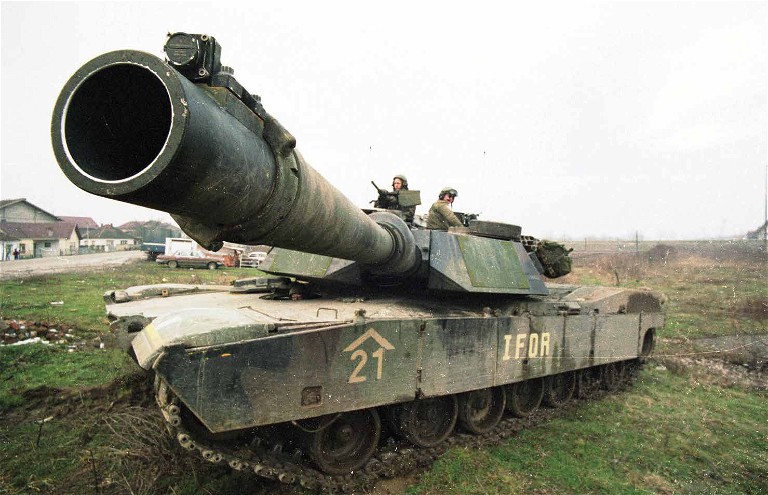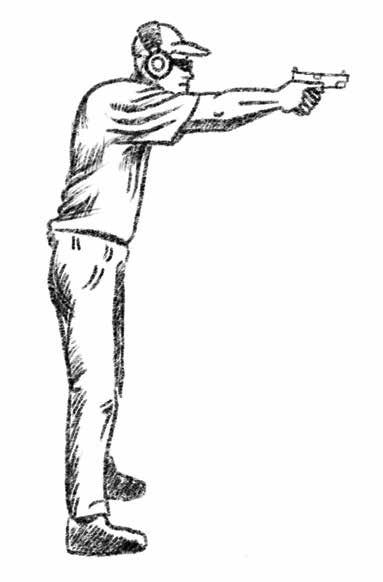STEVE HOUSEAL
BEYOND THE ISOSCELES
ADOPTING A HOLISTIC FIGHTING STANCE

‘LIKE A WHAT?’
You often hear instructors say that your torso should “function like a tank turret.” But is that really a good plan, and is the traditional isosceles stance really the best for self-defense training?
The isosceles stance is arguably the most commonly taught and used technique today — especially among private citizens. To the credit of its developers and promoters, the isosceles stance addresses several of the shortcomings of other popular techniques when applied to high-stress, high-adrenaline situations. For example, the Weaver stance, while proven effective in competition, is more difficult to master and relies on fine motor skills that evaporate under the adrenaline rush of life-threatening danger. The isosceles stance is easy to teach and easy to understand, making it a boon to instructors and new shooters alike, who may often have only a few hours together (at best). Still, the widely used isosceles stance suffers from major shortcomings. Even though it’s easy to grasp, it is rarely executed correctly, especially by relatively new shooters or those who shoot infrequently, thus magnifying its limitations.
Having taught shooting and personal-protection classes for decades, I have closely observed how both new and experienced shooters manage their firearms and how they absorb and respond to training. The isosceles stance, despite its virtues, suffers from a host of issues. In short, the isosceles stance is unnatural and thus destined to fail without constant training. While it seems simple on the surface, it is actually difficult to perform correctly, especially under stress, because it is counter to the body’s natural tendencies and attributes. Even when someone is practicing scenarios on the range, the isosceles stance has proven to lend itself to poor accuracy, poor gun-handling, poor recoil management, slow rates of fire and poor situation management. I have watched countless shooters start out on the range in the classic isosceles form, only to watch it fall apart within just a few rounds as nature takes over. Even worse is that it is a poor choice in a real-world tactical encounter because it is unstable and severely limits both the threat area an individual can cover and his or her ability to move — whether to engage targets, find a better position or exit.
Despite any claims to the contrary, the isosceles stance is a static range shooting stance for limited target presentations. At best, it allows a person to engage a stationary target, directly ahead, at close range. Adding a few closely spaced targets does not change that reality. It is inflexible, unnatural, unadaptable and immobile. It severely restricts a person’s ability to effectively maneuver, rapidly respond to a changing situation or multiple opponents, maintain accurate shooting, or develop the situation to bring it to a successful close by either exiting the danger zone or winning the fight. It is not a tactical fighting stance. If we are to be effective in defensive deadly force encounters, we must do better.
FIGHTING STANCE
Breaking down the “holistic fighting stance,” for lack of a better term, the first step is to embrace the concept of a stable fighting platform. Make it second-nature to instantly check your ability to move into one at any given moment. The stable fighting platform is at the heart of your primary stance. It is essential to sustained accurate shooting and to effective tactical response.
To get into the appropriate stance, crouch slightly and position your feet shoulder-width or slightly farther apart, with one foot a short-to-medium comfortable step ahead of the other. Your body weight should be shifted forward so that about 60 percent is over the front leg — as if facing a strong wind — and your upper body slightly forward or upright, with your weight slightly on the balls of your feet. It will become a simple second-nature act because it matches your body’s natural response to a perceived close physical threat.
Notice that it is stable and that knocking you off-balance would be difficult.

TRADITIONAL ISOSCELES
The isosceles stance is unnatural, which brings with it a whole host of issues for almost all shooters.
You can easily rotate in a great arc and move explosively in almost any direction. Should you place your right foot or left foot forward? It doesn’t matter, so adopt whatever is natural for you. I tell students not to think about it but rather to just do it. Some surprise themselves; I can push on them and not disturb them, which helps them realize just how stable they really are in this position.
Now let’s compare the holistic fighting stance to the isosceles stance. If a person correctly executes the isosceles stance, he or she is always on the razor edge of instability. (Most do not execute it correctly.) Your feet should be in line, shoulder-width apart, with your knees slightly bent. You should be leaning forward from the waist, with your arms pushed straight forward. Who stands like that? The answer is nobody.
Stability is nonexistent, and the slightest push — let alone people careening into you during a real-world encounter — will send you reeling for balance or flat onto your back or face. Your upper body rotation is severely limited, and forget about moving rapidly in any direction — especially at an angle from where you are. Most shooters begin to lean backward in a misguided (and unsuccessful) attempt to manage recoil, but that is a natural response induced by the isosceles stance itself. Few maintain the necessary forward upper-body lean.
A great many people devolve from an isosceles into a “Frankenstein” stance: locked knees, locked elbows and an immobile position. Although not intended, that is almost its natural endpoint. To make matters worse, those same people will often shoot with unlocked wrists. A shooter will control his or her pistol like a fisherman has control of a fish on the end of the line: The fish might not get away, but the individual is hardly in full control of the rod as he or she struggles to reel the fish in.
As shooters push their arms forward in the isosceles stance, watch how many fully extend them, with their elbows turned down and locked. The recoil is now focused entirely on their skeletal frames. The stance is like the cannons of old in that, when fired, they roll backward out of position and their crews have to haul them back into place for their next shots. In such a position, a shooter cannot rotate his or her upper body more than about 45 degrees to either side. Combine this inability to observe and engage with the inherent instability and immobility and you realize how poor a fighting stance the isosceles really is. Your body has skeletal, muscular and hydraulic (circulatory) systems that are your natural recoil-management tools if you use them correctly.
At full, locked extension, gun control comes only from the arm muscles, which rapidly fail. Here’s a simple test: Hold a dumbbell fully extended to either the front or side; your arm muscles rapidly get fatigued and fail. Move that weight just halfway back toward your body and it is much easier to maintain control for a much longer time. Now consider that at the end of that locked arm, with overstressed major muscles, you are trying to make small, very controlled movements with a minor digit (your trigger finger) using very minor muscles. The problems continue to compound.
For the holistic fighting stance, after you’ve learned a correct two-handed hold and proper trigger control, hold the handgun with the correct grip directly in front of your chest, with your elbows touching your body. You must have a stable fighting platform. Now, as in the isosceles stance, with both eyes open and your head up, simply push the gun toward the target, but stop the instant your arms want to stop moving. Having a stable fighting platform will make it easy to resist the isosceles stance’s unnatural-but-inevitable inclination to keep pushing your arms out until your elbows lock. Viewed from above, the arms form shallow “V”s, running from the shoulder to the elbow, then back into the gun.
With your stable fighting platform and effective upper body “turret,” you can rapidly turn to observe and engage over 90 degrees in either direction. Simple, small, natural foot movements add to this. As the upper body turns, the inside arm’s elbow naturally bends more and drops down, allowing the turn to continue. Swinging back, the arms smoothly and naturally assume their former positions, or anything in between. Your unlocked elbows and natural weight-forward posture make for effective recoil control and rapid, accurate shooting.
The holistic fighting stance provides rapid, stable, 360-degree rotation and coverage — the opposite of the isosceles stance. Let’s say you are left-foot forward in your stable fighting platform and a deadly threat appears to your right. Your natural body rotation lets you smoothly and easily traverse your upper body 90 degrees to the right.
Need more? Simply pivoting to the right on the balls of your feet lets you turn your stance 90 degrees to the right without disturbing your stability or fast, accurate shooting.
Need to turn completely around? Just a pivot on the ball of your right foot and a short step with your left positions you in the opposite direction from which you started — still stable, still shooting fast and accurately, and still fighting.
Need to go left? Pivot left on the ball of the right foot, make a short, sweeping step with your left foot, and you are still in your stable platform — still shooting effectively, now facing 90 degrees to the left of your original orientation.
At any moment, you can move explosively to another position. It would take at least four people in a defensive square using the isosceles stance to match what you can do in the holistic fighting stance, and they would still lack your mobility and flexibility. In a deadly force encounter, you must dominate your personal battle space, and the holistic fighting stance provides you with the best chance to do so.

A HOLISTIC STANCE
A more natural stance allows for greater range of movement and higher endurance.
It lends itself to effective instruction because it can easily be taught, understood and practiced one component at a time before bringing them all together. Students find that it is natural and smooth, they tend to quickly grasp it, and they are soon able to execute it well and intuitively — which is exactly what we strive for in effective shooting and tactical response.
PERFECT HARMONY
Today, the isosceles stance is widely taught and used, and for plenty of very good reasons. When he or she executes it correctly, a shooter can accurately engage targets to the front, and when performed correctly, it is more than enough for most shooting applications. But it is often not performed correctly and, while it seems simple, it requires regular training in order to be effective (and that’s if you have perfectly functioning shoulders). It can suffer from instability, immobility and limited fields of observation and fire, especially if the shooter in question experiences physical limitations. The holistic fighting stance is a system that is in harmony with the body and provides for rapid, accurate shooting and effective response in real-world tactical situations — not just higher scores on the firing line.